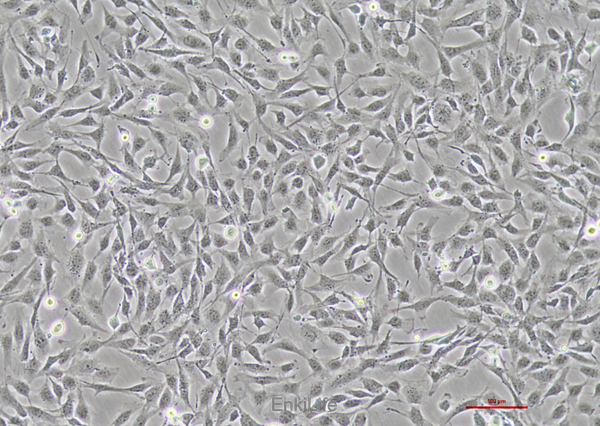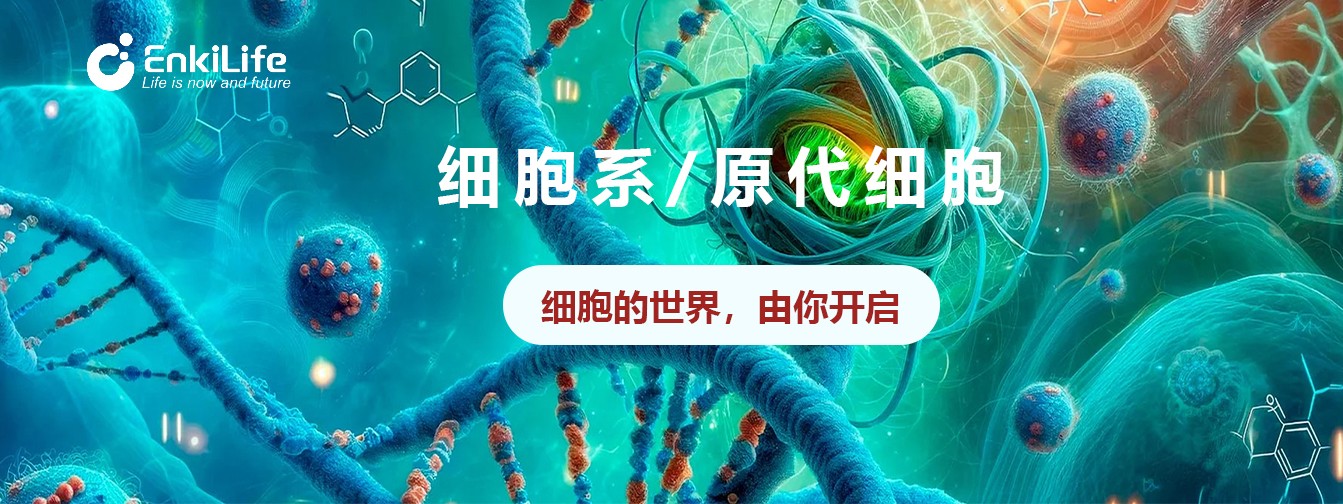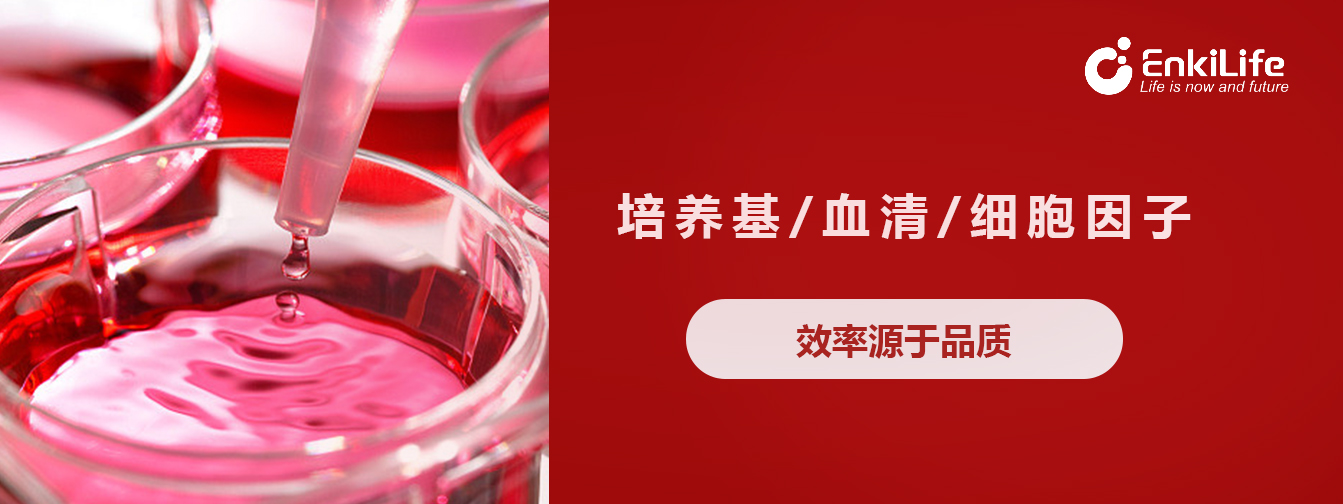永生化人脑微血管内皮细胞hCMEC/D3
发表时间:2025-07-15永生化人脑微血管内皮细胞hCMEC/D3
一. 细胞来源
1.建立方法:hCMEC/D3细胞系通过慢病毒载体转导人端粒酶(hTERT)或SV40大T抗原,对原代人脑微血管内皮细胞进行永生化处理获得。经有限稀释克隆筛选,最终选定稳定表达内皮标志物的克隆[6]。
2.组织来源:细胞源自成人颞叶组织分离的脑微血管内皮细胞,保留正常二倍体核型(46, XY)[5]。

二.生物学特性
1. 内皮标志物表达:
- 组成性表达CD31、VE-cadherin、von Willebrand因子(vWF)等内皮特异性蛋白[6]。
- 表达血脑屏障(BBB)关键转运蛋白:ABCB1(P-gp)、ABCG2(BCRP)、ABCC家族(MRP1-5)及转铁蛋白受体[2][8]。
2. 屏障功能:
- 形成紧密连接:表达occludin、claudin-5、ZO-1等连接蛋白,跨内皮电阻(TEER)值可达30–50 Ω·cm2[10][17]。
- 极化分布P-gp:定位于顶膜,介导罗丹明123等底物的定向外排(顶→基底侧渗透性低于逆向)[8]。
3. 功能活性:
- 药物外排功能:ABCB1抑制剂(如tariquidar)可阻断P-gp介导的底物外排(半衰期≈13分钟)[8]。
- 炎症响应:受细胞因子刺激后上调ICAM-1/VCAM-1等黏附分子,促进免疫细胞迁移[17]。
三. 培养与储存
1. 培养条件:
- 基础培养基:内皮细胞生长培养基(EGM-2),需添加5%胎牛血清(FBS)、碱性成纤维细胞生长因子(bFGF)及氢化可的松[6]。
- 基质包被:建议使用胶原/纤维连接蛋白包被培养皿以增强贴壁[3]。
2. 传代与储存:
- 传代比例1:3至1:4,高传代稳定性(≥38代)仍维持P-gp表达[8]。
- 冻存液:90% FBS + 10% DMSO,液氮长期保存[6]。
四. 研究应用领域
1. 药物转运研究:
- 评估BBB穿透性:吗啡、普萘洛尔等小分子药物的跨膜渗透系数(Pe)测定[2]。
- 外排转运体底物鉴定:如天麻活性成分4-HBd被证实为P-gp底物[18]。
2.疾病模型构建:
- 感染与炎症:研究脑膜炎奈瑟球菌、疟原虫等病原体突破BBB的机制[5]。
- 肿瘤相关屏障:与胶质瘤细胞共培养构建血肿瘤屏障(BTB),揭示CD73低表达致紧密连接破坏及瘤周水肿[15]。
3 . 新型递药系统开发:
- 载体评估:锌-咪唑聚合物(ZIPs)作为脑靶向载体的细胞摄取研究[16]。
- 受体介导转运:CRM197(白喉毒素突变体)通过结合白喉毒素受体增强大分子入脑[9]。
五. 近年研究进展
1. 屏障调控机制:
- 缺氧损伤修复:高压氧预处理通过上调occludin表达减轻缺氧诱导的BBB通透性增加[10]。
- 间充质干细胞外泌体(sEVhypoxic):低氧预处理的sEV促进hCMEC/D3增殖、迁移及管形成,改善缺血后神经功能[11]。
2.信号通路研究:
- 白果内酯通过抑制A1腺苷受体,下调ERM/MLC磷酸化,可逆性增加BBB通透性[14]。
- 层流剪切应力(5–10 dyn/cm2)激活NRF2通路,增强抗氧化防御并抑制炎症反应[19]。
六. 局限性与克服方法
1. 局限性:
- TEER值低于体内水平(≈2000 Ω·cm2),紧密连接完整性较弱[6][17]。
- 部分转运体表达量低于原代细胞(如P-gp),功能活性需验证[4][8]。
2.优化策略:
- 共培养模型:与星形胶质细胞共培养可提升TEER值及连接蛋白表达[1][14]。
- 动态培养系统:应用剪切应力装置模拟血流,增强屏障功能并诱导细胞极化[19]。
- 基因编辑技术:CRISPR/Cas9敲入特定基因(如CLDN5)以强化紧密连接[15]。
七. 总结与展望
hCMEC/D3作为首个稳定永生化人脑微血管内皮细胞系,为BBB研究提供了标准化、高通量工具。其在药物转运、病原体侵袭及神经疾病机制研究中成果显著。未来方向包括:
1.复杂体外模型:开发3D微流体芯片整合周细胞/胶质细胞,模拟神经血管单元[7]。
2.疾病精准建模:结合患者来源iPSC分化内皮细胞,构建个体化BBB模型[3]。
3.人工智能辅助:利用机器学习预测药物渗透性,加速中枢神经系统药物研发[18]。

参考文献
1. Weksler BB, et al. Blood‐brain barrier‐specific properties of a human adult brain endothelial cell line. FASEB J. 2005;19(13):1872-1877. PMID: 16141364.
2. Weksler BB, et al. The hCMEC/D3 cell line as a model of the human blood brain barrier. Fluids Barriers CNS. 2013;10:16. PMID: 23531482.
3. Poller B, et al. The human brain endothelial cell line hCMEC/D3 as a human blood‐brain barrier model for drug transport studies. J Neurochem. 2008;107(5):1358-1363. PMID: 19014381.
4. Tai LM, et al. Polarized P-glycoprotein expression by the immortalised human brain endothelial cell line, hCMEC/D3, restricts apical-to-basolateral permeability to rhodamine 129. Brain Res. 2009;1292:25-310. PMID: 19635469.
5. Hao L, et al. Hyperbaric oxygen preconditioning ameliorates blood-brain barrier damage induced by hypoxia through modulation of tight junction proteins. J Mol Neurosci. 2016;58(4):511-513. PMID: 26886721.
6. Daniels BP, et al. Immortalized human cerebral microvascular endothelial cells maintain the properties of primary cells in an in vitro model of immune migration across the blood brain barrier. J Neurosci Methods. 2013 Jan 15;212(1):173-9. PMID: 23068604.
7. Katt ME, et al. Human Brain Microvascular Endothelial Cells Derived from the BC1 iPS Cell Line Exhibit a Blood-Brain Barrier Phenotype. PLoS One. 2016;11(4):e0152104. PMID: 27071062.
8. 云南中医药大学等. 天麻脑保护活性成分跨血脑屏障的转运方式研究. 中国中药杂志. 2024;49(5):1301-1308.
9. 王博等. CD73在胶质瘤瘤周水肿发生发展中的作用机制研究. 中华神经外科杂志. 2017;33(2):168-178.
10. Chiacchia M, et al. Zinc-imidazolate polymers (ZIPs) as a potential carrier to brain capillary endothelial cells. J Mater Chem B. 2015;3(47):9242-9249.
11. 王萍. 白喉毒素无毒突变体CRM197介导大分子物质通过血脑屏障效果和机制的研究. 中国药理学通报. 2010;26(3):333-332.
12. Gregorius J, et al . Small extracellular vesicles obtained from hypoxic mesenchymal stromal cells have unique characteristics that promote cerebral angiogenesis, brain remodeling and neurological recovery after focal cerebral ischemia in mice. Basic Res Cardiol. 2021 Jun 8;116(1):40. PMID: 34105014.
13. 梁文意. 白果内酯调节血脑屏障通透性的作用及其机制研究. 中草药. 2020;51(11):2965-2977.
14. Choublier N, et al. Exposure of hCMEC/D3 to laminar shear stress induces vascular protective responses. Fluids Barriers CNS. 2022;19(1):22. PMID: 35765013.
15. Daniels BP, et al . Immortalized human cerebral microvascular endothelial cells maintain the properties of primary cells in an in vitro model of immune migration across the blood brain barrier. J Neurosci Methods. 2013 Jan 15;212(1):173-9. PMID: 23068604.
16. Seetharaman S, et al. Multidrug resistance-related transport proteins in isolated human brain microvessels and in cells cultured from these isolates. J Neurochem. 1998 Mar;70(3):1151-9. PMID: 9489736.
17. Abbott NJ, R?nnb?ck L, Hansson E. Astrocyte–endothelial interactions at the blood–brain barrier. Nat Rev Neurosci. 2006;7(1):41-52. PMID: 163719491.
18. Hatherell K, et al. Development of a three-dimensional, all-human in vitro model of the blood-brain barrier using mono-, co-, and tri-cultivation Transwell models. J Neurosci Methods. 2011 Aug 15;199(2):223-9. PMID: 21609734.




